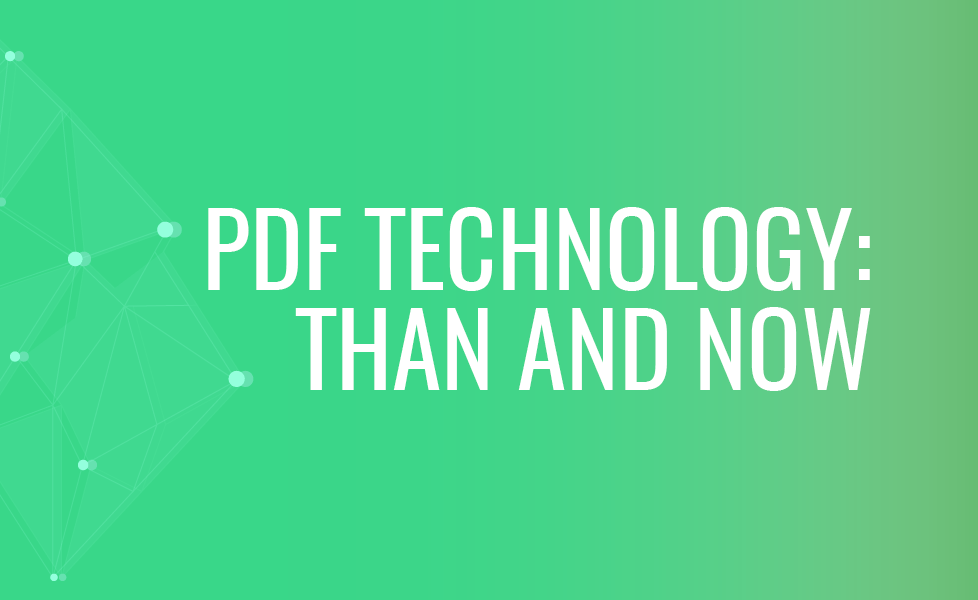PDF Technology: Then and Now

The Portable Document Format (PDF) has been around for decades, but many people do not know what it is and what makes it different. Once the file format that documents were rendered in at their final stage for presentation and archiving, now PDF has become hugely crucial at every aspect of a company’s processes. What is excellent about PDF is that it is always improving, with new features and capabilities being added to it constantly.
What is PDF?
According to Adobe, “Portable Document Format (PDF) is a file format used to present and exchange documents reliably, independent of software, hardware, or operating system…PDFs can contain links and buttons, form fields, audio, video, and business logic.” Particular to PDF is that text and graphics are stored in vector form, meaning that the content within the file is dependent solely on the output device (monitor, printer) and is rendered exactly as you expect it to. This is known as ‘What You See Is What You Get’ which was originally coined for the PDF format itself. Other features include annotation, digital signatures and import/export form data. PDFs can be easily viewed using free and paid for software supplied by numerous companies across the world.
What is evident from the definition above is that PDF is not merely a file format, it is a container for many different types of media and business-specific processes. A text document, presentation slides and a spreadsheet can all be part of one PDF document, as well as images, videos and links to other documents or online resources. It is so much more than a final stage file format for a document.
Past days
PDF initially was made popular in the print industry. With so many file formats that printed differently depending on margins, printer type, etc., print professionals found that PDF files printed exactly what was on the page, exactly as they wanted it. By converting other file formats into PDFs the ‘What You See Is What You Get’ concept enabled the print industry to become more efficient. It also allowed client companies to get involved in the print process through the use of Adobe Photoshop, Illustrator and other visual editing software, converting them to PDF at the end of the process, ready for print.
Companies saw the benefit of this format and also the need to view documents in a consistent format that gave them the ability to annotate, sign and view documents across many devices. This opened organizations up to integrating PDF technology into many different processes within businesses.
Present day
Now companies use PDF technology within processes, applications and in archiving. Used cases are endless of how companies have incorporated PDF technology into desktop and mobile applications and throughout complex processes to make them easier to carry out. PDF technology has taken a more active role in organizations, allowing companies to be more efficient, decreasing the time spent on admin and other aspects of the business.
Holding a stand-alone ISO Standard and a special place with EIDAS and ESIGN, PDF is leading the way in document management, forcing others to keep up or get left behind. With the likes of the PDF/X, PDF/A, PDF/E Standards, etc, document management, archiving and readability have compliant criteria that ensure anyone working with or on PDF technology can carry out their goals efficiently and effectively.
Why use a PDF Software Development Kit (SDK)
Using a free PDF editor or viewer is excellent — for a while. But they need updating, have limited features and functionality, you may need to use two or three of them to achieve all your document management needs, and document customization is out of the question. If you have a development team at your disposal, using a PDF SDK can save your company time and money by incorporating high-performance PDF technology throughout your systems. This means that you no longer have to think about when you need to use PDF technology when doing your job, it just happens. And automatic actions can be pre-programmed or added through the front-end meaning those without development skills can use the software through a UI.
The business opportunities are endless: PDF technology is an ISO standard and digital signatures are as highly regarded as their paper equivalent. Investing in PDF technology is investing in the future success of your business. Try our MobilePDF SDK today and see what it can do for your company in 2018!